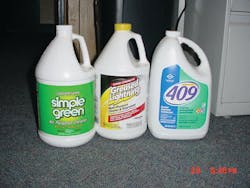Decontaminating Investigation Equipment: Clearing Traces of Ignitable Liquids
During a recent court case, the following question was asked by the defendant’s attorney. “What method of decontaminating your fire investigations equipment was used to prevent cross contamination of the scene?” As you can imagine, this doesn’t usually turn out great for the prosecution in any case. With one sentence, the private investigator for the insurance company raised enough doubt in the jury’s eyes to sway the jury to a not guilty verdict when the investigator said, “I haven’t washed my bunker boots in 20 years!”
Taking the loss of this case and wanting to prevent others like it, investigators with the City of Thornton (CO) Fire Department found a need to have a written guideline to be followed by all of our department personnel. A guideline to decontaminate as much equipment as possible, and prevent cross contamination of the scene and evidence collected on future incidents.
After calling other investigators in the Denver Metropolitan area, as well as checking the Internet in an effort to see what other departments use for decontaminating equipment, I was unable to come up with any guidelines or procedures. With the lack of information in the investigations community, I decided to conduct a “decontamination experiment.”
With the assistance of Colorado Bureau of Investigations agent Jerry Means and his partner, accelerant detection canine Sadie, the experiment was conducted testing three commonly used multi-purpose cleaners and degreasers: Greased Lightning, manufactured by HomeCare Labs; Simple Green, manufactured by Sunshine Makers, Inc.; and Formula 409, manufactured by Clorox Professional Products Company.
We had four two-gallon plastic buckets with lids, and purchased the aforementioned cleaning products plus three each of the following: two-inch pure bristle paint brushes with wooden handles, two-inch concrete/masonry trowels with hard plastic handles, plastic putty knife, wooden paint stirring sticks, leather and canvas work gloves, a two-inch by four-inch piece of rubber from an inner-tube (similar to the rubber of rubber bunker or day boots), and an eight-inch by eight-inch piece of denim from a pair jeans.
To make sure each item to be used during the testing was not already contaminated, Agent Means and K9 Sadie conducted a “sniff” of all items. The items were placed throughout the fire station in an area that no accelerant or ignitable liquid should be found – bedrooms, office, television room and a hallway.
Once Agent Means and K9 Sadie determined all items to be tested were free of ignitable liquids, a two-gallon bucket was filled halfway with absorbent, and then eight ounces of gasoline was added to the absorbent. This mixture was used to simulate ignitable liquid-laced ash that could be found at the scene of a structure fire. The lid was then placed on the bucket, and the absorbent and gasoline mix was shaken to ensure adequate dispersion of the gasoline in the absorbent.
After the fuel/absorbent mixture was prepared, all of the items to be tested were placed in the fuel/absorbent bucket, the lid placed back on, and the bucket was shaken so the fuel/absorbent could be transferred to each item. While this was occurring, Agent Means and K9 Sadie completed a “sniff” of the apparatus bay at the fire station to ensure no ignitable liquids were present, which could lead to false positives during the next phase of testing. As hard as it is to believe, the fire station apparatus bay was actually found to be clean!
All items to be tested were removed from the fuel/absorbent mixture bucket, one at a time, and placed throughout the apparatus bay. To eliminate the possibility of cross contamination, clean nitrile gloves were used with each item as it was removed from the bucket and placed on the floor. Agent Means and K9 Sadie then conducted another “sniff” and determined all items to be tested did in fact test positive for ignitable liquids.
Once the items tested positive they were all collected, again using clean nitrile gloves with each item, and then separated in preparation for decontamination using the three cleaners/degreasers.
Based on the directions for use found on each container, each with different dilution recommendations or no recommendations listed at all, a ratio of one part cleaner to five parts water was prepared. All contaminated items were then rinsed with a garden hose, allowing any debris or contaminants to flow into an apparatus bay floor drain. Once all items were rinsed, they were placed into the prepared solution and were allowed to soak for 30 minutes.
Following the 30-minute soak, the items were removed and re-rinsed with the garden hose, again allowing debris and contaminants to flow into the apparatus floor drain. After the second rinse, the bucket was rinsed as well and a new batch of cleaning solution and water was prepared, again at a ratio of one part cleaner to five parts water.
Using a new scrub brush, all items tested were scrubbed in the solution and then re-rinsed a third time. Items such as the piece of rubber from the inner-tube, cement/masonry trowel, paint brush and wooden paint stirring stick were put on a clean towel and placed in the basement of the fire station to air dry for 24 hours. The canvas/leather work glove and patch of denim were taken to a washing machine and ran through a cold normal wash cycle using phosphate-free laundry soap, then allowed to air dry in the basement as well.
After the 24-hour drying period, all of the items were collected using clean nitrile gloves and placed throughout the fire station, again in the bedrooms, office, television room and hallway. Some items that were intentionally not decontaminated by using any of the three cleaners, but had been rinsed only, had been placed in the apparatus bay for testing as well.
Agent Means and K9 Sadie then conducted a “sniff” of all the items tested. Based on the “sniff” results the Greased Lightning multi-purpose cleaner and degreaser showed to be the most effective in decontaminating common fire investigations tools and clothing. Of all items tested, the piece of inner-tube rubber was the only item that could not be decontaminated by the Greased Lightning.
Formula 409 showed to be the second-most effective of the three cleaners, leaving the canvas/leather work glove and inner-tube rubber testing positive for an ignitable liquid. Simple Green showed to be the least effective of the three cleaners, leaving the canvas/leather work glove, denim patch, and inner-tube rubber testing positive for an ignitable liquid. All items that had been rinsed with water only, tested positive for an ignitable liquid, as expected.
Based on the test results the attached department standard operating guideline was written and it's attached below to download.
As past and current origin and cause determination practices come under scrutiny in the public eye, be it in written media or television, all fire department personnel, more specifically, fire investigators, need to do everything within our means to prevent cross contamination of fire scenes and our evidence. If not, we can expect to continue losing court cases because of that little legal term known as reasonable doubt.
How do you decontaminate your equipment?
BRENT BURKE is a lieutenant and fire investigator with the City of Thornton, CO, Fire Department. He has been in the fire service for 17 years, with 11 years fire-investigations experience conducting more than 200 investigations to include multiple fire-fatality incidents. Burke holds an associate of applied science degree in fire science from Red Rocks Community College, certificate of study in criminal justice from the Community College of Aurora, is a Colorado Peace Officer Standards and Training (POST) certified commissioned peace officer, and is a National Association of Fire Investigators Certified Fire and Explosion Investigator and Certified Fire Investigation Instructor.
About the Author

Brent Burke
For Firehouse.com
Brent Burke is a Lieutenant & Fire Investigator with the City of Thornton(CO)Fire Department. Brent holds an Associate of Applied Science degree in Fire Science from Red Rocks Community College, Certificate of Study in Criminal Justice from the Community College of Aurora, is a Colorado Peace Officer Standards & Training (POST) certified commissioned peace officer, & is a National Association of Fire Investigators Certified Fire & Explosion Investigator & Certified Fire Investigation Instructor.
